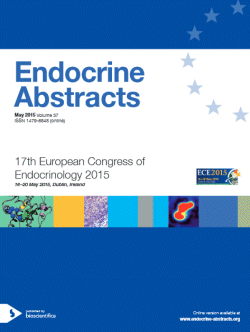Guided Posters
Reproduction: Male and endocrine disruptors
ea0037gp.08.01 | Reproduction: Male and endocrine disruptors | ECE2015
Characteristics and predictors of primary hypogonadism in ageing men: longitudinal data from the European Male Ageing Study
Ahern Tomas B , Huhtaniemi Ilpo T , Carter Emma L , Finn Joseph D , Pye Stephen R , O'Neill Terence W , Bartfai Gyorgy , Casanueva Felipe F , Forti Gianni , Giwercman Aleksander , Han Thang S , Kula Krzysztof , Lean Michael EJ , Pendleton Neil , Punab Margus , Vanderschueren Dirk , Wu Frederick C W
ea0037gp.08.02 | Reproduction: Male and endocrine disruptors | ECE2015
Deregulation of Sertoli and Leydig cells function in patients with Klinefelter syndrome as evidenced by testis transcriptome analysis
Ferlin Alberto , D'Aurora Marco , Nicola Marta Di , Garolla Andrea , Toni Luca De , Franchi Sara , Palka Giandomenico , Foresta Carlo , Stuppia Liborio , Gatta Valentina
ea0037gp.08.03 | Reproduction: Male and endocrine disruptors | ECE2015
Infertile men have frequently Leydig cell dysfunction: study on hypogonadism, vitamin D and bone mass in 5177 subjects
Ferlin Alberto , Garolla Andrea , Selice Riccardo , Caretta Nicola , Pizzol Damiano , Foresta Carlo
ea0037gp.08.04 | Reproduction: Male and endocrine disruptors | ECE2015
Triclosan-induced breast cancer growth was antagonised by kaempferol, a phytoestrogen, via regulating cell cycle, migration and apoptosis related genes in MCF-7 breast cancer cells
Kim Seung-Hee , Hwang Kyung-A , Choi Kyung-Chul
ea0037gp.08.05 | Reproduction: Male and endocrine disruptors | ECE2015
Involvement of oestrogen receptor-α in λ-cyhalothrin and cypermethrin-induced cancer growth in BG-1 ovarian cancer cells expressing oestrogen receptor
ea0037gp.08.06 | Reproduction: Male and endocrine disruptors | ECE2015
Bisphenol A affects amelogenesis by modulating enamel key genes expression
Jedeon Katia , Houari Sophia , Mcalpin Blake , Loiodice Sophia , Berdal Ariane , Babajko Sylvie
ea0037gp.08.07 | Reproduction: Male and endocrine disruptors | ECE2015
Cord blood insulin-like peptide 3 is reduced in idiopathic cryptorchidism and inversely related to free bisphenol A: a marker and/or an actor of foetal exposure to endocrine disruptors?
Fenichel Patrick , Lahlou Najiba , Chevalier Nicolas , Coquillard Patrick , Panaia-Ferrari Patricia , Wagner-Mahler Kathy , Pugeat Michel , Brucker-Davis Francoise
ea0037gp.08.08 | Reproduction: Male and endocrine disruptors | ECE2015
Evidence of stimulation of pubertal development and suppression of growth rate in boys smoking marijuana in cigarettes
Jabeen Shagufta , Raja Ghazala Kaukab , Akram Maleeha , Ahmad Afzal , Qayyum Mazhar , Rizvi Shakeel Raza




